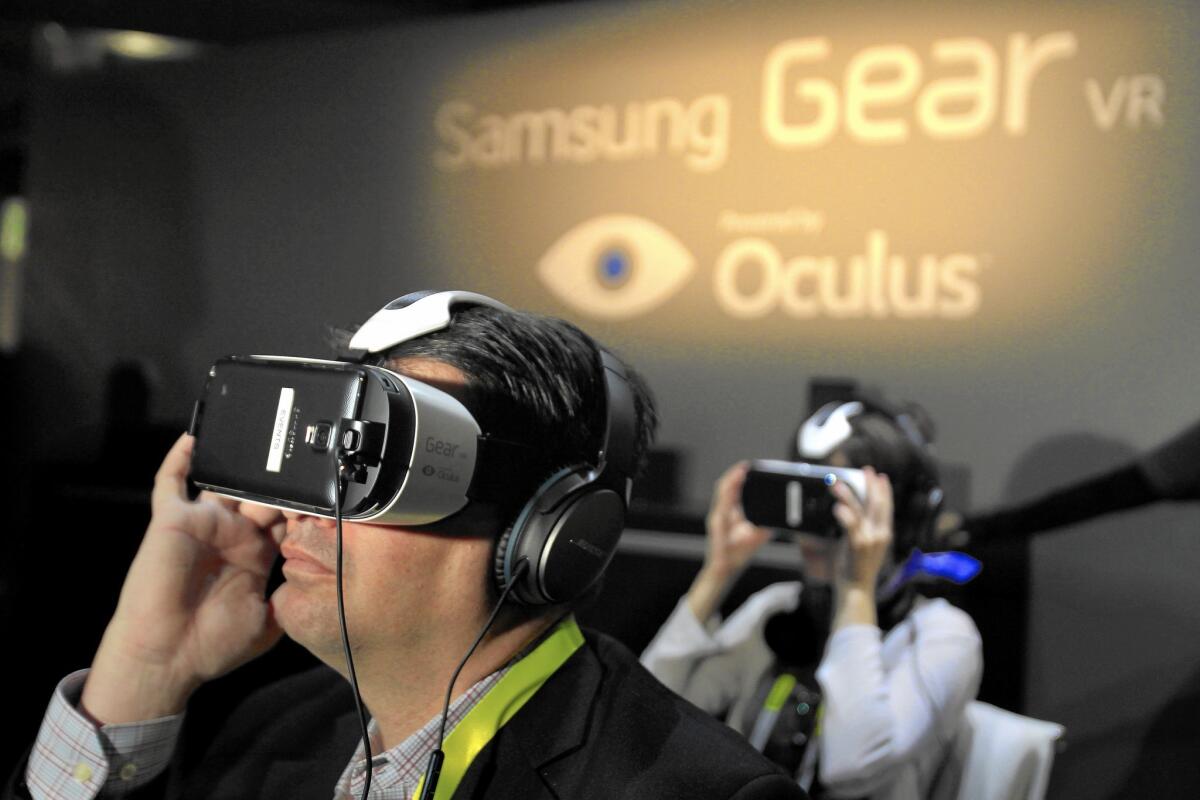Virtual reality isn’t just for video games

Reporting from las vegas — When people think of virtual reality, they think games. Put on a helmet where VR systems are being demonstrated, and chances are you’ll be immersed in a video game. Here you are in a spaceship cockpit. Now you’re driving a race car. Oh, look, you’re dodging bullets, “Matrix”-style, in a shooter game. Watch out behind you!
Sounds like fun, but virtual reality, despite all the hype, is not yet ready for prime time, for video games or anything else. The hardware remains big and clunky. The immersive experience in a fast-action environment still makes too many people sick in their stomachs.
While they work to iron out those problems, VR makers like Oculus — a Southern California start-up acquired by Facebook last year for $2 billion — are exploring additional market opportunities to increase their chances of success.
At the consumer electronics show CES in Las Vegas this week, those who donned the Oculus Rift ski goggle-like headset were transported to a video and audio alternative reality, a museum where a lively T-Rex awaited with menace. Lean in, and you could almost feel its breath on you.
In the same demo, people were virtually lifted to the top of a skyscraper; if they walked to the edge and leaned over, they could see bustling traffic hundreds of feet below. It triggered the fear of heights in more than one show attendee.
In another vignette, a Pixar-like fight scene between two robots played out in 360-degree video, inviting users to look left, right and behind them to follow the action.
The presentation was designed as a “tasting plate” of the possibilities for VR.
“We’ve said from the beginning we’re big gamers, and we started Oculus to deliver consumer VR and revolutionize games,” said Nate Mitchell, Oculus’ vice president for product. “But it may well end up being that VR is more about film than games.” He’s not sure that’s the case, “but it’s possible. We don’t know what the killer app is.”
Maybe it’s movies? Maybe video games? Maybe military simulation training? The company is working with outside developers on content for all three.
Hollywood studios are deeply involved in exploring the possibilities of virtual reality entertainment, “pretty much all of them,” Mitchell said.
The Sundance Film Festival, to be held in Utah this month, said it has selected at least 13 short VR movies for presentation.
Jaunt VR, a Palo Alto company, has developed a prototype 3-D camera that records in 360 degrees so users can make their own virtual reality films. The company has already released two videos of concerts on Google Play that give users a 360-degree view of the concert stage. They can watch it without a VR headset by using their phone’s screen as a window to the concert. For a more immersive experience, they can also use it with the Oculus gear or Google’s low-cost Cardboard VR headgear.
Outside of film, Redwood City, Calif.-based AltspaceVR is building software for meetings and conferences in virtual reality. In the AltspaceVR app, users appear as a Wall-E-like avatar. The app uses the head tracking capabilities of virtual reality headsets to determine where a person is looking and how his or her head is moving, and translates that into the avatar’s movements. It also simulates being in an actual physical space with other people by allowing users to hear someone better if that person’s avatar is closer. Getting really close to someone’s avatar lets users whisper.
“We think VR has this opportunity to be a new communications medium,” said AltspaceVR Chief Executive Eric Romo. “There’s a lot of things you can do with nonverbal communication inside virtual reality that are not really possible on other platforms.”
On the phone, users can’t tell whether the person on the other end of the line is paying attention. In group conference calls, people tend to accidentally talk over one another. AltspaceVR tries to communicate nonverbal cues.
“In VR, I can have that information; I can see it,” Romo said. “So we can communicate in this more natural way than we could on chat or telephone. Obviously, there’s stuff that video brings to the table that VR can’t do in the short term, but there’s a lot more VR can offer there.”
It will be awhile before companies hold staff meetings via virtual reality avatars — if ever. Other workplace uses for VR are more immediate. Dan Ward, co-founder of mobile app development company Detroit Labs, believes the coming year will see various industries use VR for training — think combat simulation for the military; natural disaster drills for police, firefighters and paramedics; auto repair education; and so on.
“In the past, we’ve spent billions of dollars re-creating situations for people to train in,” Ward said. “But these VR head units are able to trick the mind really well, and we all know that a lot of training is mental, so there’s a massive opportunity here.”
Another VR headset maker, Sulon Technologies, showed software prototypes that allow users to walk around a life-sized virtual engine. Sulon founder and CEO Dhan Balachand said technology like this could change the way product design teams work, allowing them to visualize products and parts in a virtual space before committing to manufacturing. The company foresees its Cortex headset changing the way people buy cars: Forget the showroom, put on a VR headset and a car materializes in front of you, allowing you to change its color and add or remove features.
Although hopes are building among companies and potential customers for affordable VR, there aren’t yet any high-definition consumer headsets on the market. Early adopters can pick up the Oculus Rift developer kit, and Samsung has released the “Innovator Edition” (that is, not for the mass market) of its mobile-powered Gear VR headset, but every major headset maker, including Oculus and Sony, has said its hardware isn’t ready yet. It’s hard to get people to make content for a headset that no one owns. Mitchell isn’t fazed, though.
“Obviously, it’s way too early for a $50-million blockbuster VR film because there’s no way to sell it to people yet,” he said. “But I think in the next few years we’ll get there. It’s still early days. It’s blue skies.”
Twitter: @traceylien
More to Read
Inside the business of entertainment
The Wide Shot brings you news, analysis and insights on everything from streaming wars to production — and what it all means for the future.
You may occasionally receive promotional content from the Los Angeles Times.











